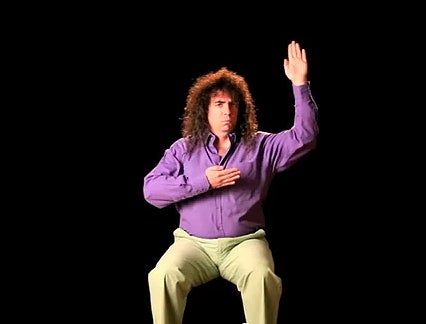|
View video here.
February 3, 2012
Aphasia: A Stanford music professor's work, with hand gestures and odd sounds, about 'obsessive attention to ridiculous things'
Mangled vocal samples, random icons and precise hand gestures come together in a mesmerizing performance by Stanford music scholar Mark Applebaum. By Camille Brown

Mark Applebaum performing Aphasia The performer in the video steps onto the stage and sits down in a nondescript chair, his face blank of expression and hands placed squarely on his knees.
Suddenly, a metallic-sounding "THWUNK!" electrifies the space and with a sharp left-arm gesture the performer strikes his chest, beginning the performance of Aphasia, a composition by Mark Applebaum, associate professor of music at Stanford.
Aphasia is a 9-minute piece expressly written for a "singer" to perform without making a single sound. Premiered in February 2011 during a Stanford Lively Arts event, Aphasia consists of hundreds of transformed vocal samples derived from the voice of professional baritone Nicholas Isherwood and set to a score of hand motions coordinated to each sound.
While the piece was inspired by a conversation between Isherwood and Applebaum, the idea to write a piece for a mute singer with hand motions was Applebaum's own "obsession." His intention was to have Aphasia come across as a metaphor for "expressive paralysis," something that unnerves him every time he "confronts the terror of composing a new piece."
So how does one go about the paradox of writing a composition for a performance that has no form of verbal communication or written words?
Applebaum began by collaborating with Isherwood to produce the sounds, a collection of three hours of Isherwood singing. The singing consisted of "a bunch of crazy sounds – very strange things I asked of him." From there Applebaum isolated individual samples and transformed his selections radically through computer processes. The result, he said, "was a garbled voice of sorts."
Applebaum then choreographed "a kind of invented nonsense sign language" to accompany the now otherworldly sound sequence. Based on everyday activities, the gestures were recorded as a written musical score, using icons with names such as "give me the money" and "Post-it Notes."
These gestures, each of which are described in detail in the work's appendix, are intended to reflect the composer's fascination in "absurdity that seems to be the consequence of tedious, obsessive attention to ridiculous things." Or, in other words, how bizarre the actions of our mundane routine of activity seem when they are examined out of context.
Obsessive attention to ridiculous things
The allure of "obsessive attention to ridiculous things" also pervaded Applebaum's rehearsal process for the piece and, in turn, guided its performance. Even though he composed the piece over the course of a year, it took Applebaum four more months to memorize the score for a live performance.
The avant-garde score has no regular rhythms or predictable points of repetition, and relies on a stream of unrelated icons representing hand movements. Applebaum described memorizing those 9 minutes as a daunting task. It is decidedly old school: The performer must memorize the entire score and learn the micro-timing of the rhythms so that a sense of visual mimesis results.
"There is no logic of consequence to lean on. I mean, there is no real-world situation in which 'Rubik's cube twist' [a gesture in the piece] should follow 'saw board.'"
The performance shown in the video is entirely unedited. Applebaum pointed out that while there are a few places where the timing is a little off, there's just one mistake, and only he would notice.
The piece's mercurial juxtaposition of hand gestures presents another problem for the singer. "Unlike more traditional musical discourses," Applebaum said, "you can't really scan ahead in your mind to think about later parts of the piece while executing the present. The maximum window of attention for this piece is alarmingly small – about two to three seconds at maximum."
However, it's the fast-paced and unexpected nature of Aphasia in performance that gives it charm and broad appeal. Since the piece is so far removed from what is recognized as common musical practice, it is equally accessible to music experts and novice listeners alike. As Applebaum points out, "Kids love it. So do people who need a break from conventional modes of expression."
Camille Brown is an intern with the Human Experience, the Humanities web portal for Stanford University.
-30-
|